#sumerian
Text
Out of the many incredible artifacts that have been recovered from sites in Iraq where flourishing Sumerian cities once stood, few have been more intriguing than the Sumerian King List.
26 notes
·
View notes
Photo
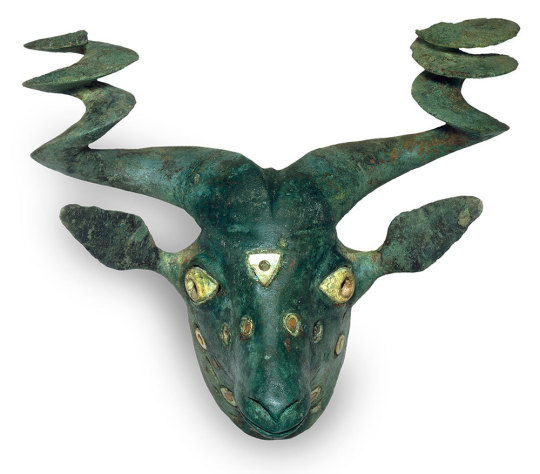
Markhor Goat Head - copper alloy, shell, and red stone - Sumerian, Early Dynastic III, c. 2550–2250 BCE
12K notes
·
View notes
Text
Something that I get chills about is the fact that the oldest story told made by the oldest civilization opens with "In those days, in those distant days, in those ancient nights."
This confirms that there is a civilization older than the Sumerians that we have yet to find
Some people get existential dread from this
Me? I think it's fucking awesome it shows just how much of this world we have yet to discover and that is just fascinating
#the epic of gilgamesh#gilgamesh#enkidu#sumerian#ancient history#world history#history#ancient sumeria#sumeria#ancient times#ancient civilizations#bronze age#ancient literature#ancient legends#mesopotamia#ancient mesopotamia#akkadian#mythology#sumerian mythology#mesopotamian mythology#mesopotamian#ancient mystery#ancient myths#ancient mythology#ancient myth#ancient legend#ancient myths and legends#ancient past#epic of gilgamesh#ancient epic
794 notes
·
View notes
Text

in love with these fragmented portions of a Sumerian lullaby
3K notes
·
View notes
Text

Detail of a temple wall from the Sumerian city of Uruk in Mesopotamia. The temple that dates back to the late 15th century BCE was dedicated to worshiping the Sumerian goddess Inanna, known as the Lady of Heaven. The Pergamon Museum, Berlin, GERMANY.
Photo by Babylon Chronicle
656 notes
·
View notes
Text

Quick drawing of Inanna in a warlike mood for pride, because with the flood of political attacks agains trans people across the world, it is closer to how I'm feeling than anything along the lines of "Happy Pride Month"
#artists on tumblr#digital art#inanna#pride month#ishtar#pride art#trans visibility#trans artwork#queer#queer art#mythologyart#sumerian#mythology
1K notes
·
View notes
Text
something that kind of bothers me about modern feelings toward the epic of gilgamesh is how it's been COMPLETELY watered down to being "gay". Bear with me as I explain.

this is more of an extreme example, but I see this take all the time (not the yaoi part. the gay lover part). it's boiled down to the fact that it's gay over literally anything else in the epic. Gilgamesh's lament to Urshanabi about Enkidu's loss is overshadowed by the fact that Gilgamesh is mourning his gay lover. Gilgamesh is on a journey because he lost his gay lover. Gilgamesh and Enkidu were gay.
Now I understand that with a modern lens, people tend to lock on to how unabashedly Gilgamesh mourns Enkidu, because it's gay and because it's the oldest written epic in human history. People feel deeply connected to the idea that people like them have been around since the dawn of literature. But placing exclusive focus on the nature of the relationship as gay, rather than why the relationship or its loss was important, erases the story the epic is trying to tell.
The Epic of Gilgamesh is a story about love, yes, but it is not a love story. It's about the fear of death, coping with loss, and desperation to stave off the inevitable. It's about the bonds of friendship, about hardship, coming to terms personal change and losing pieces of yourself as you learn and grow. It is about consequences, arrogance, death, second chances, mourning, yearning, loving and LIVING. The Epic of Gilgamesh is about the entire human experience and one man's struggle to accept it. What does it mean to have lived? What does it mean to have loved, and lost? What does it mean to die, and to be remembered? What does it mean to be human?
It is perfectly okay to find appreciation for the Epic because of Gilgamesh and Enkidu's relationship. But also understand that the world's oldest story is not about two gay men who loved each other. It is a story about being alive.
TLDR;
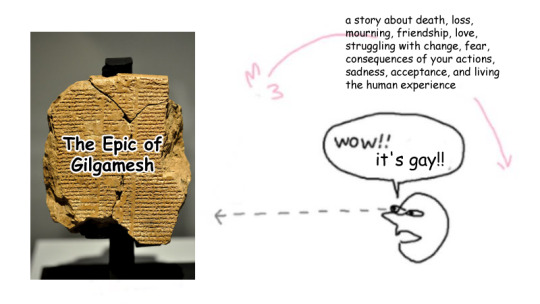
#the epic of gilgamesh#mesopotamia#sumerian#once again recommending that everyone read the epic of gilgamesh at least once because it really is a great story#gilgamesh and enkidu's relationship is first of all--a minor detail at best. homosexuality was normal in sumerian society#so it wouldn't have been unusual. in fact placing such intense focus on it is what's unusual#also they weren't even homosexual. they both also sleep with women. but the erasure of bisexuality is a completely different hornet's nest#i could also probably write a post about how watered down the whole ea-nasir thing is too#but hes so much of a meme i might as well try to convince a brick wall to get up and walk for all the good it'd do#anyway. im pretentious about this topic because i love it so fucking dearly. please recognize what it is youre appreciating
291 notes
·
View notes
Text

388 notes
·
View notes
Text
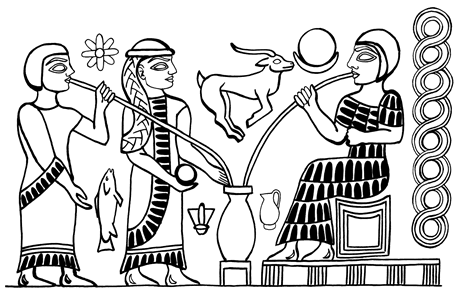
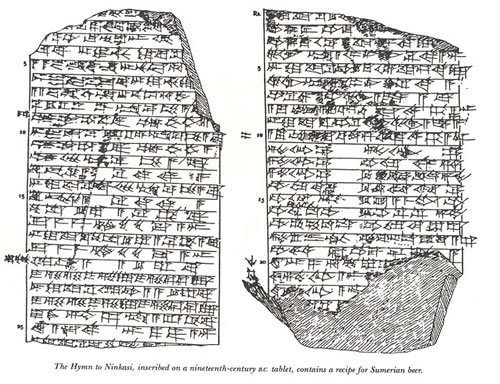

The Hymn of Ninkasi
The Ancient Sumerians loved their beer. In fact they loved their beer so much that thousands of years later ancient recipes and artwork depicting beer making and beer drinking survive to this day. Many of these recipes are being recreated and brewed thousands of years later by crafted breweries today. They drank it for ceremonial and religious reasons, they drank it for nutritional reasons, and they drank it for the same reasons we drink it today. You know ... to get pissed.
The Sumerians were so serious about their beer that they had their own deity devoted to the beverage named Ninkasi. Ninkasi was the goddess of beer and alcohol, who brewed the beverage daily to to “satisfy the desire” and “sate the heart.” One of the earliest known devotions to Ninkasi was a hymn written on clay tablets dating to 1800 BC. Called “The Hymn to Ninkasi” it was more than just a devotional script or prayer, it was a recipe and procedure for brewing, written as a poem so that it would be easy to remember in an age when most people were illiterate. The beer that was produced was a very sweet beverage with around 3.5% alcohol by volume, created by brewing with malt and a twice baked honey bread (bappir) that had the taste and consistency of granola. It would have been very sweet compared to modern beer as the Sumerians lacked hops which gives the bitter flavors of beers today. Traditionally the beer was stored in clay pots and sipped using long drinking straws to filter out left over particulates.
The Hymn of Ninkasi
Borne of the flowing water,
Tenderly cared for by the Ninhursag,
Borne of the flowing water,
Tenderly cared for by the Ninhursag,
Having founded your town by the sacred lake,
She finished its great walls for you,
Ninkasi, having founded your town by the sacred lake,
She finished it’s walls for you,
Your father is Enki, Lord Nidimmud,
Your mother is Ninti, the queen of the sacred lake.
Ninkasi, your father is Enki, Lord Nidimmud,
Your mother is Ninti, the queen of the sacred lake.
You are the one who handles the dough [and] with a big shovel,
Mixing in a pit, the bappir with sweet aromatics,
Ninkasi, you are the one who handles the dough [and] with a big shovel,
Mixing in a pit, the bappir with [date] - honey,
You are the one who bakes the bappir in the big oven,
Puts in order the piles of hulled grains,
Ninkasi, you are the one who bakes the bappir in the big oven,
Puts in order the piles of hulled grains,
You are the one who waters the malt set on the ground,
The noble dogs keep away even the potentates,
Ninkasi, you are the one who waters the malt set on the ground,
The noble dogs keep away even the potentates,
You are the one who soaks the malt in a jar,
The waves rise, the waves fall.
Ninkasi, you are the one who soaks the malt in a jar,
The waves rise, the waves fall.
You are the one who spreads the cooked mash on large reed mats,
Coolness overcomes,
Ninkasi, you are the one who spreads the cooked mash on large reed mats,
Coolness overcomes,
You are the one who holds with both hands the great sweet wort,
Brewing [it] with honey [and] wine
(You the sweet wort to the vessel)
Ninkasi, (…)(You the sweet wort to the vessel)
The filtering vat, which makes a pleasant sound,
You place appropriately on a large collector vat.
Ninkasi, the filtering vat, which makes a pleasant sound,
You place appropriately on a large collector vat.
When you pour out the filtered beer of the collector vat,
It is [like] the onrush of Tigris and Euphrates.
Ninkasi, you are the one who pours out the filtered beer of the collector vat, It is [like] the onrush of Tigris and Euphrates.
299 notes
·
View notes
Photo
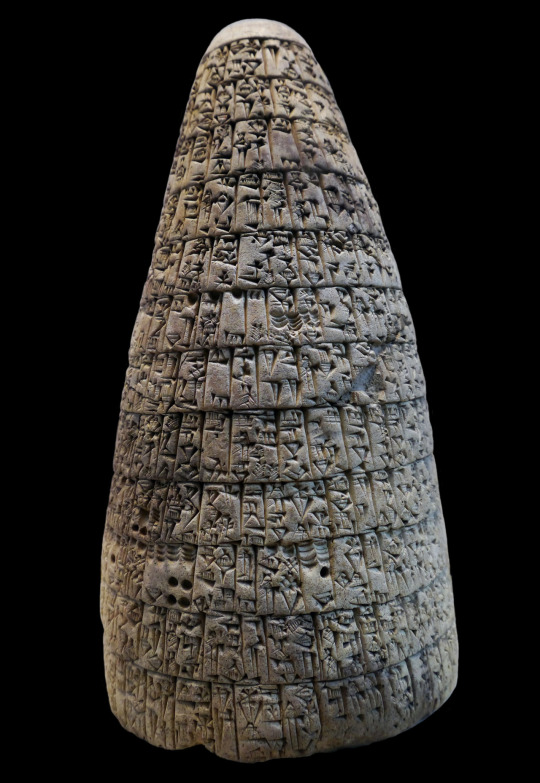
Cone of Urukagina, king of Lagash, circa 2350 BC,
Girsu, Mesopotamia,
Detailing his reforms againt abuse of "old days".
Height: 27 cm (10.6 in); diameter: 15 cm (5.9 in).
Collections of the Louvre (Department of Near Eastern Antiquities).
#art#design#sculpture#writing#words#king of lagash#girsu#mesopotamia#le louvre#cone#urukagina#styl#history#ideographic#cuneiform#sumerian
836 notes
·
View notes
Photo
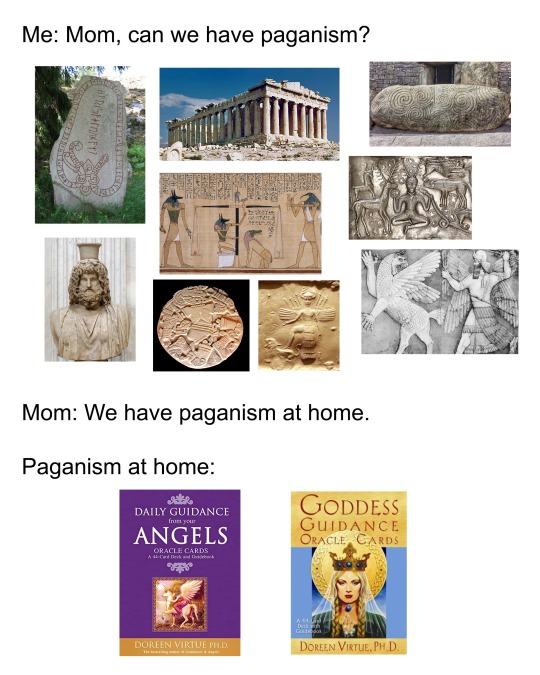
#pagan memes#paganism#neopaganism#memes#hellenic paganism#hellenic polytheism#helpol#norse paganism#asatru#egyptian paganism#kemeticism#mesopotamian mythology#sumerian#celtic paganism#doreen virtue
738 notes
·
View notes
Link
Since I haven’t seen it on tumblr yet, here’s an article on a major piece of Sumerian news - the recent discovery of the palace and temple at Girsu! Girsu was, for a time, the capital city of Lagash, its political peak occurring roughly halfway through its more than four millennia of occupation. The temple was dedicated to the city’s patron deity, Ninngirsu, a god of agriculture and warfare.
#sumerian news#sumerian#sumerian archaeology#sumerian mythology#archaeology#girsu#also I just realized this is my 1500th post on this blog! exciting
427 notes
·
View notes
Text


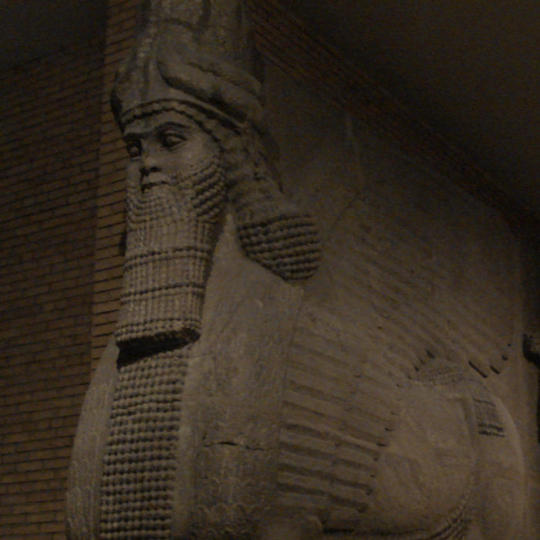
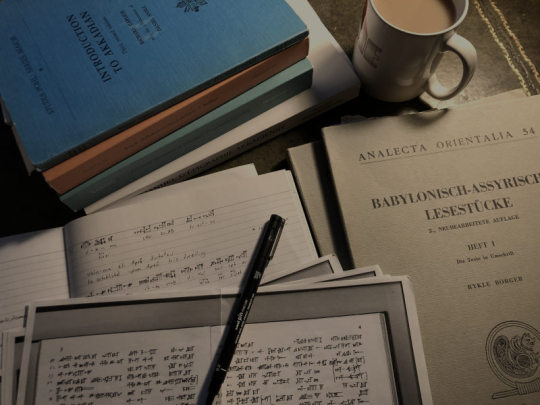
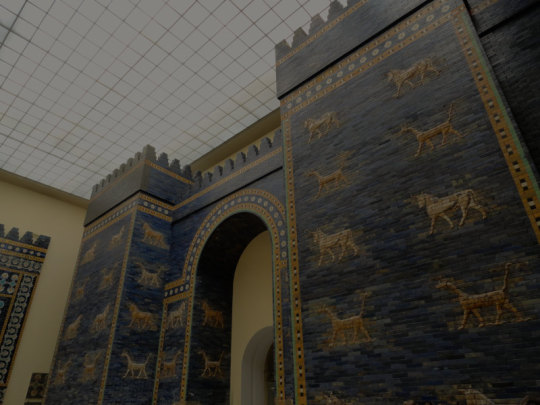



𒀜𒋫𒋫𒀜𒁕𒇷𒅁𒈪𒈾𒀀𒋫𒀠𒄣
𒀸𒁕𒆷𒉿𒌅𒌦𒈾𒄩𒊏𒌋𒌋𒅗
Epic of Gilgameš X.297-8
("you kept toiling ceaselessly without sleep. what did you get? / you are exhausting yourself with ceaseless toil")
#dark academia post from an alternate reality where donna tartt studied ancient mesopotamia instead of classics#what if the dark academia ur-text was actually about Ur?#ninhurtag#dark academia#dark acadamia aesthetic#chaotic academia#grey academia#dark aesthetic#akkadian#sumerian#mesopotamia#gilgamesh#studyblr#moodboard#ἐποίησα
111 notes
·
View notes
Text
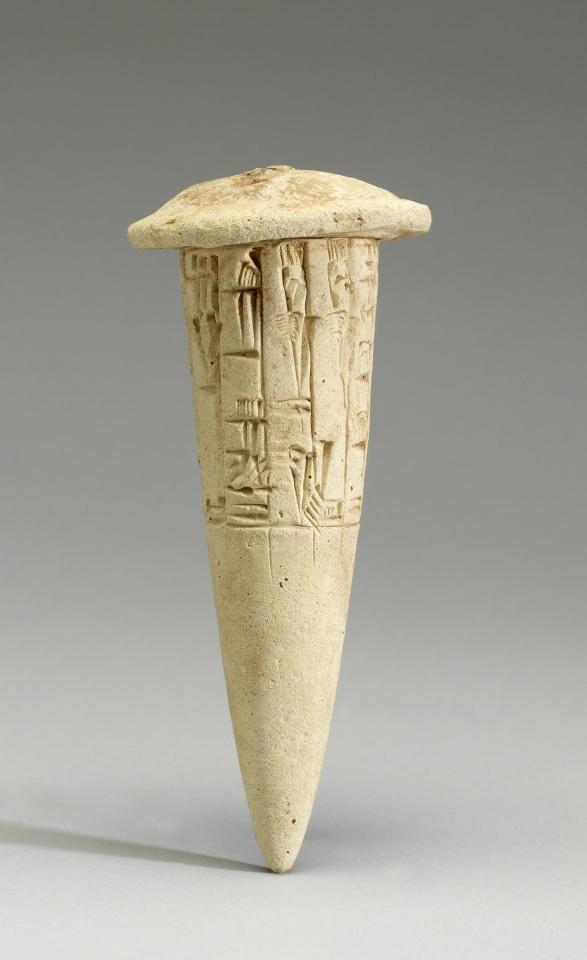
Nail of Gudea
Sumerian, ca. 2144-2124 BCE (Lagash II; Ur III [Neo-Sumerian])
Clay cones and nails were inscribed in the name of a ruler of a Mesopotamian city-state to commemorate an act of building or rebuilding, often of a temple for a specific deity. Deposited in the walls or under the foundations of these structures, the words of the texts were directed at the gods but would be found by later restorers.
130 notes
·
View notes
Text

486 notes
·
View notes
Text

Sumerian foundation figure, dating back to the Early Dynastic period around 2900–2350 BCE. The Pergamon Museum, Berlin, GERMANY.
Photo by Babylon Chronicle
252 notes
·
View notes